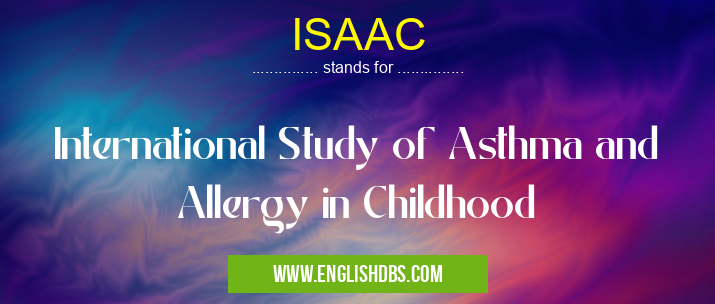What does ISAAC mean in DISEASES
ISAAC (International Study of Asthma and Allergies in Childhood) is an international study that investigates the prevalence of asthma and allergic diseases in children and adolescents worldwide. The study was initiated in 1991 and has since been conducted in over 200 centers in more than 50 countries.

ISAAC meaning in Diseases in Medical
ISAAC mostly used in an acronym Diseases in Category Medical that means International Study of Asthma and Allergy in Childhood
Shorthand: ISAAC,
Full Form: International Study of Asthma and Allergy in Childhood
For more information of "International Study of Asthma and Allergy in Childhood", see the section below.
Objectives
The main objectives of ISAAC are to:
- Determine the prevalence and trends of asthma and allergic diseases in children and adolescents globally.
- Identify risk factors for the development of these conditions.
- Evaluate the effectiveness of preventive and treatment strategies.
Methodology
ISAAC uses a standardized questionnaire to collect data on respiratory symptoms, allergies, and lifestyle factors from children and adolescents aged 6-7 and 13-14 years. The questionnaire is administered by trained interviewers who are blinded to the participants' health status.
Findings
ISAAC has found that asthma and allergic diseases are common worldwide, affecting millions of children and adolescents. The prevalence of these conditions has been increasing in recent decades, particularly in developing countries.
ISAAC has also identified several risk factors for asthma and allergic diseases, including:
- Family history of asthma or allergies
- Exposure to tobacco smoke
- Air pollution
- Obesity
- Early exposure to allergens
Essential Questions and Answers on International Study of Asthma and Allergy in Childhood in "MEDICAL»DISEASES"
What is the International Study of Asthma and Allergy in Childhood (ISAAC)?
ISAAC is a global research program that has been monitoring the prevalence and trends of asthma and allergies in children and adolescents since the early 1990s. It aims to understand the causes and risk factors for these conditions and to track changes over time.
How many countries are involved in ISAAC?
ISAAC has been conducted in over 200 countries and regions around the world, involving millions of children and adolescents.
How are data collected in ISAAC?
ISAAC uses standardized questionnaires to collect data on respiratory symptoms, allergies, and socio-economic factors from children and their parents. The questionnaires are translated into multiple languages and administered by trained personnel.
What has ISAAC found out about asthma and allergies?
ISAAC has found that asthma and allergies are common worldwide, affecting a significant proportion of children and adolescents. The prevalence of these conditions has increased in many countries over the past few decades, particularly in urban areas.
What are the risk factors for asthma and allergies identified by ISAAC?
ISAAC has identified several risk factors for asthma and allergies, including exposure to tobacco smoke, air pollution, and certain allergens such as dust mites, pollen, and pet dander. Other factors such as family history and certain genetic variations also play a role.
How is ISAAC data used?
ISAAC data is used to inform public health policy, develop prevention and treatment strategies, and advocate for resources to address the burden of asthma and allergies. It also helps track the effectiveness of interventions and provides insights into the evolving epidemiology of these conditions.
Final Words: ISAAC is a valuable resource for understanding the prevalence, risk factors, and treatment of asthma and allergic diseases in children and adolescents worldwide. The data collected by ISAAC has helped to inform public health policies and research efforts aimed at preventing and controlling these conditions.
